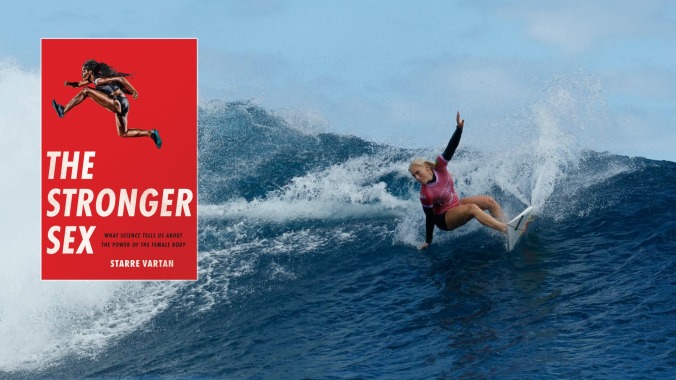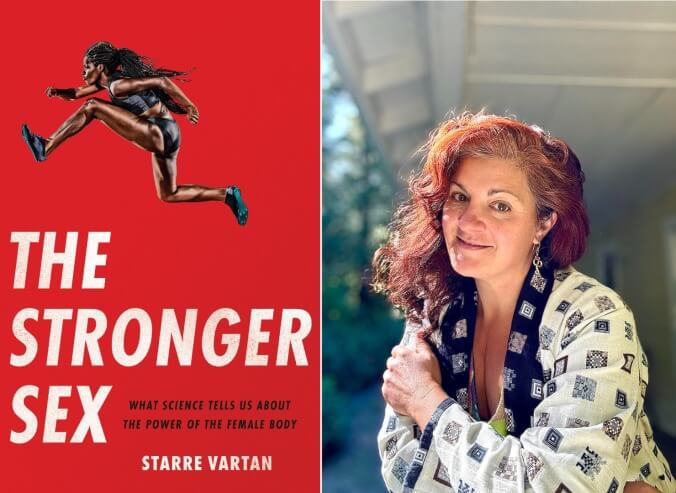Women’s Bodies May Actually Be Inherently Stronger—But Science Is Only Just Figuring It Out
The Stronger Sex, a new book by Starre Vartan, paints a picture of the female body as strong, capable, and gifted in ways that post-industrial societies have ignored.
Photo Credit: Ben Thouard-Pool/Getty Images BooksEntertainment
It’s hardly radical to say that women’s bodies are inherently smaller and weaker than men’s bodies—but research compiled in Starre Vartan’s illuminating new book The Stronger Sex: What Science Tells Us About the Power of the Female Body reveals that that conventional wisdom is actually largely a myth.
Growing up, Vartan was a strong, independent kid who pushed her body to the limit. “I knew I was strong because I could do … tasks that adult men often performed in other homes and on TV.” But her experience of girlhood was unusual, as she writes in The Stronger Sex: Girls build less muscle mass than boys from childhood—not necessarily because their bodies can’t, but because they aren’t expected to or given the opportunities to, a disparity that lasts throughout life. These gendered expectations have long-term implications for women’s bodies, the way we think about them, and the way science has approached studying them.
Though culture can affect biology, in most cases, our ideas about gender are dictated by culture alone, especially when it comes to sports. Vartan argues in her book that, if we knew more about the female body, and let female athletes compete alongside their male counterparts, we would get to see how extraordinary the female body can really be. Vartan’s book also delves into the many exciting ways research and individuals are pushing back against the myth that women are innately weaker and more delicate than men. In her conversations with scientists who are studying endurance, longevity, and autoimmunity—all areas where the female body excels—Vartan paints a picture of the female body as strong, capable, and gifted in ways that have not often been celebrated. As studies in these areas proceed—and, as Vartan emphasizes, incorporate more diverse genders and the unique experiences of trans people—we will know more about our bodies than we ever have before.
“If dudes had these abilities, we would hear about them constantly and they would be so celebrated and it would be so important,” she said when we spoke over Zoom earlier this month. It’s time for women’s bodies to get their due as well.
This interview has been edited for length and clarity.
Throughout the book, you’re interrogating the idea of what is biologically innate versus what is socially constructed. Could you talk about how those different dynamics affect female capabilities?
The crux of your question is exactly what I was weighing the whole time. You could argue that female bodies are stronger than male bodies in all these ways, but the deeper question is, Why do we ask what bodies are stronger in the first place, and what do we mean by strength?
In the research, I found time and time again that how we grow up and what we grow up doing shapes our bodies for the rest of our lives, pre-puberty and through puberty. At this point, we can’t actually know how strong a female body can get because of the repression, discouragement, lack of training, lack of knowledge, lack of opportunity, and lack of finances that girls face. When we talk about sports, we often think of our own culture here in the United States or Australia or Europe, but many top athletes come from less developed countries. Young women in those countries are still doing a lot of the housework and a lot of the childcare within their families. They are not playing soccer in the street or basketball down at the court. So they never have the opportunities that boys in their community might.
And women are just starting to have the ability, in the most advanced Western cultures, to see what their capabilities are. That starts with childhood. We see it in young girls who play sports with their brothers. In places where some of those constraints are removed from young female bodies, they tend to excel. So we know that there is a larger space for female bodies to go in terms of athletics, and strength in general and physical abilities of all kinds. We just haven’t, at least in the last 7,500 years or so, had a large-scale, community-wide or culture-wide availability for women and girls to challenge themselves—in fact, we’ve actively disempowered them. We’ve taken physical tasks away, in some cases for what seemed like benign or good reasons; like, we don’t wanna tax the pregnant woman. Even in a fairly egalitarian home, if there’s lifting or carrying, it’s a guy’s job.
-

-

-

-

-

-

-

-

-

-

-

-

-

-

-

-

-

-

-

-

-

-

-

-

-

-

-

-

-

-

-

-

-

-

-

-

-

-

-

-









































